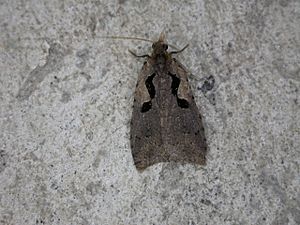Black-lyre leafroller moth facts for kids
Quick facts for kids Black-lyre leafroller moth |
|
|---|---|
 |
|
| Adult in Papanui, New Zealand | |
| Scientific classification | |
| Kingdom: | |
| Phylum: | |
| Class: | |
| Order: | |
| Family: | |
| Tribe: |
Cnephasiini
|
| Genus: |
"Cnephasia" (see text)
|
| Species: |
"C." jactatana
|
| Binomial name | |
| "Cnephasia" jactatana Walker, 1863
|
|
| Synonyms | |
|
See text |
|
Meet the black-lyre leafroller moth ("Cnephasia" jactatana), a small but interesting moth! It belongs to a group of moths called tortrix moths. You can only find this special moth in New Zealand, which means it's endemic there. This moth is known for its unique patterns and its role in the environment.
About its Name
Scientists group living things into different categories. The black-lyre leafroller moth is part of the subfamily called Tortricinae. It also belongs to a smaller group, or tribe, named Cnephasiini.
However, scientists are still figuring out the exact family name for this moth. It was first placed in the Cnephasia group. But it's not very similar to the main moth in that group, called Cnephasia pasiuana, which lives in Europe.
Because of these differences, some people thought it might belong to other groups like Batodes (now called Ditula) or Paedisca (now called Epinotia). It might fit better with Epinotia, which is a very large and diverse group of moths. But for now, its true genus name is still a bit of a mystery!
What it Eats
The black-lyre leafroller moth is mostly known as a pest when it comes to kiwifruit (Actinidia deliciosa). A pest is an animal that can cause harm or damage to crops.
The young moths, called caterpillars, enjoy eating many different plants. They like trees that have juicy fruits. Some of their favorite foods include Citrus fruits, hawthorn trees (Crataegus), and persimmons (Diospyros). They also munch on gum trees (Eucalyptus), fuchsia plants (Fuchsia), and grapevines (Vitis).
These caterpillars mostly eat the leaves of these plants. But they can also cause damage to the fruit itself. They might chew on the outer skin or even the fruit inside.
Life Cycle
The female moth lays her tiny eggs on the top side of plant leaves. She often chooses older leaves to lay her eggs on. Once the eggs hatch, the caterpillars begin to feed and grow.
Images for kids




